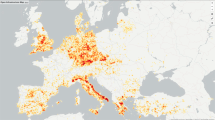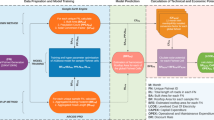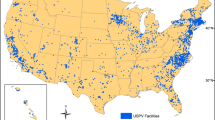Abstract
Photovoltaic (PV) solar energy generating capacity has grown by 41 per cent per year since 20091. Energy system projections that mitigate climate change and aid universal energy access show a nearly ten-fold increase in PV solar energy generating capacity by 20402,3. Geospatial data describing the energy system are required to manage generation intermittency, mitigate climate change risks, and identify trade-offs with biodiversity, conservation and land protection priorities caused by the land-use and land-cover change necessary for PV deployment. Currently available inventories of solar generating capacity cannot fully address these needs1,2,3,4,5,6,7,8,9. Here we provide a global inventory of commercial-, industrial- and utility-scale PV installations (that is, PV generating stations in excess of 10 kilowatts nameplate capacity) by using a longitudinal corpus of remote sensing imagery, machine learning and a large cloud computation infrastructure. We locate and verify 68,661 facilities, an increase of 432 per cent (in number of facilities) on previously available asset-level data. With the help of a hand-labelled test set, we estimate global installed generating capacity to be 423 gigawatts (−75/+77 gigawatts) at the end of 2018. Enrichment of our dataset with estimates of facility installation date, historic land-cover classification and proximity to vulnerable areas allows us to show that most of the PV solar energy facilities are sited on cropland, followed by aridlands and grassland. Our inventory could aid PV delivery aligned with the Sustainable Development Goals.
This is a preview of subscription content, access via your institution
Access options
Access Nature and 54 other Nature Portfolio journals
Get Nature+, our best-value online-access subscription
$29.99 / 30 days
cancel any time
Subscribe to this journal
Receive 51 print issues and online access
$199.00 per year
only $3.90 per issue
Buy this article
- Purchase on Springer Link
- Instant access to full article PDF
Prices may be subject to local taxes which are calculated during checkout



Similar content being viewed by others
Data availability
The dataset is publicly hosted on Zenodo and is available at https://zenodo.org/record/5005868 or https://doi.org/10.5281/zenodo.5005868. It will also be visualized and available for download via the World Resources Institute Resource Watch, and the Descartes Labs platform. Source data are provided with this paper.
Code availability
The code repository is publicly hosted on Github at https://github.com/Lkruitwagen/solar-pv-global-inventory. The code release for this publication is version 1.0.0 and is also hosted on Zenodo at https://doi.org/10.5281/zenodo.5045001.
References
Statistical Review of World Energy 2018 (BP plc., 2018).
World Energy Outlook 2018 (International Energy Agency, 2018).
Renewable Capacity Statistics 2019 (International Renewable Energy Agency, 2019).
Byers, L. et al. A Global Database of Power Plants (World Resources Institute, 2018).
Barbose, G. & Darghouth, N. Tracking the Sun (Berkeley Lab, 2019); https://openpv.nrel.gov/tracking-the-sun
Yu, J., Wang, Z., Majumdar, A. & Rajagopal, R. DeepSolar: a machine learning framework to efficiently construct a solar deployment database in the United States. Joule 2, 2605–2617 (2018).
Hou, X. et al. Solarnet: a deep learning framework to map solar plants in China from satellite imagery. In ICLR 2020 Workshop on Tackling Climate Change with Machine Learning (ICLR, 2020); https://www.climatechange.ai/papers/iclr2020/6.html
Platts, S. G. World Electric Power Plant Database (2018); https://www.spglobal.com/platts/en/products-services/electric-power/world-electric-power-plants-database
Electric Plants (IHSMarkit, 2020); https://catalogue.datalake.ihsmarkit.com/
Renewables 2019 (International Energy Agency, 2019); https://www.iea.org/reports/renewables-2019
Bolinger, M., Seel, J. & Robson, D. Utility-Scale Solar: Empirical Trends in Project Technology, Cost, Performance, and PPA Pricing in the United States (Berkeley Lab, 2019).
Fukushima, K. Neocognitron: a self-organizing neural network model for a mechanism of pattern recognition unaffected by shift in position. Biol. Cybern. 36, 193–202 (1980).
LeCun, Y. et al. Backpropagation applied to handwritten zip code recognition. Neural Comput. 1, 541–551 (1989).
Krizhevsky, A., Sutskever, I. & Hinton, G. E. Imagenet classification with deep convolutional neural networks. In Proc. 25th International Conference on Neural Information Processing Systems (NIPS’12) Vol. 1, 1097–1105 (Curran Associates Inc., 2012).
Zhang, Z., Liu, Q. & Wang, Y. Road extraction by deep residual U-Net. IEEE Geosci. Remote Sens. Lett. 15, 749–753 (2018).
Ishii, T. et al. Detection by classification of buildings in multispectral satellite imagery. In 2016 23rd International Conference on Pattern Recognition (ICPR) 3344–3349 (IEEE, 2016).
Audebert, N., Le Saux, B. & Lefévre, S. Beyond RGB: very high resolution urban remote sensing with multimodal deep networks. ISPRS J. Photogramm. Remote Sens. 140, 20–32 (2018).
Zuo, J., Xu, G., Fu, K., Sun, X. & Sun, H. Aircraft type recognition based on segmentation with deep convolutional neural networks. IEEE Geosci. Remote Sens. Lett. 15, 282–286 (2018).
Bentes, C., Velotto, D. & Tings, B. Ship classification in TerraSAR-X images with convo lutional neural networks. IEEE J. Ocean. Eng. 43, 258–266 (2018).
Gray, M., Watson, L., Ljungwaldh, S. & Morris, E. Nowhere to Hide: Using Satellite Imagery to Estimate the Utilisation of Fossil Fuel Power Plants (Carbon Tracker, 2018); https://www.carbontracker.org/reports/nowhere-to-hide/
Wang, A. X., Tran, C., Desai, N., Lobell, D. & Ermon, S. Deep transfer learning for crop yield prediction with remote sensing data. In Proc. 1st ACM SIGCAS Conference on Computing and Sustainable Societies 50 (ACM, 2018).
Wang, H. et al. Deep learning based ensemble approach for probabilistic wind power forecasting. Appl. Energy 188, 56–70 (2017).
Imamoglu, N., Kimura, M., Miyamoto, H., Fujita, A. & Nakamura, R. Solar power plant detection on multi-spectral satellite imagery using weakly-supervised CNN with feedback features and m-PCNN fusion. Preprint at https://arXiv.org/abs/1704.06410 (2017).
Malof, J. M., Bradbury, K., Collins, L. M. & Newell, R. G. Automatic detection of solar photovoltaic arrays in high resolution aerial imagery. Appl. Energy 183, 229–240 (2016).
Camilo, J. A., Wang, R., Collins, L. M., Bradbury, K. & Malof, J. M. Application of a semantic segmentation convolutional neural network for accurate automatic detection and mapping of solar photovoltaic arrays in aerial imagery. Preprint at https://arxiv.org/abs/1801.04018 (2018).
Badrinarayanan, V., Kendall, A. & Cipolla, R. Segnet: A deep convolutional encoder-decoder architecture for image segmentation. Preprint at https://arxiv.org/abs/1511.00561 (2015).
Simonyan, K. & Zisserman, A. Very deep convolutional networks for large-scale image recognition. In International Conference on Learning Representations (2015); preprint at https://arxiv.org/pdf/1409.1556.pdf
Ronneberger, O., Fischer, P. & Brox, T. U-Net: Convolutional networks for biomedical image segmentation. Preprint at https://arxiv.org/abs/1505.04597 (2015).
He, K., Zhang, X., Ren, S. & Sun, J. Deep residual learning for image recognition. Preprint at https://arxiv.org/abs/1512.03385 (2015).
Wu, G. C. et al. Power of Place: Land Conservation and Clean Energy Pathways for California (The Nature Conservancy, 2019).
Konadu, D. et al. Land use implications of future energy system trajectories: the case of the UK 2050 carbon plan. Energy Policy 86, 328–337 (2015).
Turconi, R., Boldrin, A. & Astrup, T. Life cycle assessment (LCA) of electricity generation technologies: overview, comparability and limitations. Renew. Sustain. Energy Rev. 28, 555–565 (2013).
Hernandez, R. et al. Environmental impacts of utility-scale solar energy. Renew. Sustain. Energy Rev. 29, 766–779 (2014).
Bukhary, S., Ahmad, S. & Batista, J. Analyzing land and water requirements for solar deployment in the southwestern United States. Renew. Sustain. Energy Rev. 82, 3288–3305 (2018).
Dias, L., Gouveia, J. P., Loureno, P. & Seixas, J. Interplay between the potential of photovoltaic systems and agricultural land use. Land Use Policy 81, 725–735 (2019).
Grodsky, S. M. & Hernandez, R. R. Reduced ecosystem services of desert plants from ground-mounted solar energy development. Nat. Sustain. 3, 1036–1043 (2020).
Carlisle, J. E., Kane, S. L., Solan, D., Bowman, M. & Joe, J. C. Public attitudes regarding large-scale solar energy development in the U.S. Renew. Sustain. Energy Rev. 48, 835–847 (2015).
Mulvaney, D. Identifying the roots of green civil war over utility-scale solar energy projects on public lands across the American southwest. J. Land Use Sci. 12, 493–515 (2017).
Lamarche, C. et al. Compilation and validation of SAR and optical data products for a complete and global map of inland/ocean water tailored to the climate modeling community. Remote Sens. 9, 36 (2017).
Cherlet, M. et al. World Atlas of Desertification: Rethinking Land Degradation and Sustainable Land Management (Publications Office of the European Union, 2018).
Hersbach, H. et al. The ERA5 global reanalysis. Q. J. R. Meteorol. Soc. 146, 1999–2049 (2020).
Author information
Authors and Affiliations
Contributions
L.K. designed and implemented the machine learning pipeline, designed and implemented the dataset analysis, and wrote the paper draft. K.S. designed the machine learning pipeline and dataset analysis, implemented the SPOT6/7 branch of the machine learning pipeline and wrote the paper draft. J.F. and L.B. contributed to the acquisition of training data and analysis of the dataset. S.S. contributed to the deployment of the machine learning pipeline. C.H. contributed to the analysis of the dataset and wrote the paper draft.
Corresponding author
Ethics declarations
Competing interests
K.S. and S.S. are employees and shareholders of Descartes Labs Inc., the company that builds and maintains the cloud computation infrastructure used to conduct this research. J.F. and L.B. are employees of the World Resources Institute, a not-for-profit organization which will host and publicly visualize a copy of our dataset.
Additional information
Peer review information Nature thanks Fei Teng, Stefano Ermon, Rebecca R. Hernandez, Lynn Kaack and the other, anonymous, reviewer(s) for their contribution to the peer review of this work.
Publisher’s note Springer Nature remains neutral with regard to jurisdictional claims in published maps and institutional affiliations.
Supplementary information
Supplementary Information
This file contains Supplementary Information, including Supplementary Figs. 1–13, Tables 1–10 and references.
Supplementary Data
This file contains the source data for some of the supplementary figures.
Source data
Rights and permissions
About this article
Cite this article
Kruitwagen, L., Story, K.T., Friedrich, J. et al. A global inventory of photovoltaic solar energy generating units. Nature 598, 604–610 (2021). https://doi.org/10.1038/s41586-021-03957-7
Received:
Accepted:
Published:
Issue Date:
DOI: https://doi.org/10.1038/s41586-021-03957-7
This article is cited by
-
Aligning renewable energy expansion with climate-driven range shifts
Nature Climate Change (2024)
-
A 10-m national-scale map of ground-mounted photovoltaic power stations in China of 2020
Scientific Data (2024)
-
Site selection of desert solar farms based on heterogeneous sand flux
npj Climate and Atmospheric Science (2024)
-
Georectified polygon database of ground-mounted large-scale solar photovoltaic sites in the United States
Scientific Data (2023)
-
In-orbit demonstration of a re-trainable machine learning payload for processing optical imagery
Scientific Reports (2023)
Comments
By submitting a comment you agree to abide by our Terms and Community Guidelines. If you find something abusive or that does not comply with our terms or guidelines please flag it as inappropriate.



